Sunburn results from overexposure of the skin to ultraviolet (UV) radiation; wavelengths in the UVB spectrum (280 to 320 nm) cause the most pronounced effects.
(See also Overview of Effects of Sunlight Overview of Effects of Sunlight The skin may respond to sunlight with chronic (eg, dermatoheliosis [photoaging], actinic keratosis) or acute (eg, photosensitivity, sunburn) changes. The sun emits a wide range of electromagnetic... read more .)
Symptoms and Signs of Sunburn
Symptoms and signs of sunburn appear in 1 to 24 hours and, except in severe reactions, peak within 72 hours (usually between 12 hours and 24 hours). Skin changes range from mild erythema, with subsequent superficial scaling, to pain, swelling, skin tenderness, and blisters. Constitutional symptoms (eg, fever, chills, weakness, shock), similar to a thermal burn, may develop if a large portion of the body surface is affected; these symptoms may be caused by the release of inflammatory cytokines such as IL-1. Very sunburned skin may exfoliate days later.
The most common complications of sunburn are secondary infection, permanent blotchy pigmentation, and significantly increased risk of skin cancer. Exfoliated skin may be extremely vulnerable to sunlight for several weeks.
Treatment of Sunburn
Cold compresses
Nonsteroidal anti-inflammatory drugs (NSAIDs)
Further exposure should be avoided until sunburn has completely subsided. Cold tap-water compresses and oral NSAIDs help relieve symptoms, as may topical treatments (eg, aloe vera, other water-based lotions). Petrolatum-based products such as petroleum jelly should be avoided in severe sunburns. Topical corticosteroids are no more effective than cool compresses. Blistered areas should be managed similarly to other partial-thickness burns ( see Initial wound care Initial wound care  ), with sterile dressings and silver sulfadiazine.
), with sterile dressings and silver sulfadiazine.
Ointments or lotions containing local anesthetics (eg, benzocaine) or diphenhydramine typically should be avoided because of the risk of allergic contact dermatitis Allergic contact dermatitis (ACD) Contact dermatitis is inflammation of the skin caused by direct contact with irritants (irritant contact dermatitis) or allergens (allergic contact dermatitis). Symptoms include pruritus and... read more  .
.
Early treatment of extensive, severe sunburn with a systemic corticosteroid (eg, oral prednisone 20 to 30 mg 2 times a day for 4 days for adults or adolescents) may decrease the discomfort, but this use is controversial.
Prevention of Sunburn
Simple precautions Prevention The skin may respond to sunlight with chronic (eg, dermatoheliosis [photoaging], actinic keratosis) or acute (eg, photosensitivity, sunburn) changes. The sun emits a wide range of electromagnetic... read more (eg, avoiding the sun especially during midday; wearing tightly woven clothing, a hat, and sunglasses; applying sunscreens) significantly reduce the chances of sunburn.







